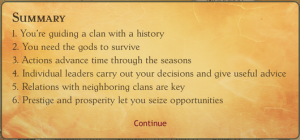Although I (David) get to be the public face of the game, nearly two dozen people helped me make it. I’d like to share some of their stories, starting with our Quality Assurance (QA) Lead, Liana Kerr.
What’s your background?

Illustration by Ellen Barkin
I dabble in writing and art, and I’ve studied Japanese for several years. I’ve done fan translations of video games and a little professional translation. I have a huge weakness for RPGs, adventure games and sim games, but I have a tendency to lose myself in games, so these days I just play a couple of mobile games that don’t require much time or brainpower. I’m the primary caregiver to my two children, six-year old Milo and one-year old Felix.
How were you introduced to KoDP
Back in college, my boyfriend presented me with a new game for Valentine’s Day. It was perfect: it had gorgeous artwork, engaging writing, a challenging scenario. I played it over and over, creating happy little Ernalda-worshipping Peace clans, exploring Dragon Pass and learning all the lore. And what of the guy who knew me so well that he gifted me a game that I played for years? I married him, of course! (And eventually we had a child who encourages me to “get lots of cows, mama!”)
How did you get into the industry?
I had been following the King of Dragon Pass blog, and I offered to help beta test the iOS version. “I have a good eye for detail,” I told David, in what may have been an understatement. Unfortunately, David already had as many beta testers as he needed. Fortunately, most people are not very good beta testers. I got in on the next round of testing, and as I hadn’t played KoDP for several years I was thrilled to be able to return to the game. Beta-testing KoDP coincided with being pregnant with my older son, and it distracted me from my constant nausea. I ended up filing so many bugs that I was convinced David was sick of this annoying fangirl who kept nitpicking his game! But instead he asked me to help test the iPad version, and sent me an iPad inscribed with “Queen of Dragon Pass.” When he started adding more new content to KoDP, I started working as a freelancer doing more formal QA, and it’s been my dream job ever since!
What was the first gaming product you worked on, and in what capacity?
King of Dragon Pass is the first game I ever worked on professionally. I’ve also worked on fan translations of some Super Famicom RPGs, both as a translator and finding bugs in the patches. (I translated Metal Max Returns several years ago, and three games that haven’t been released yet, Granhistoria, Metal Max 2 and Tenshi no Uta.) Working on Six Ages has made me want to design games myself. Maybe once the kids are older!
What was the most challenging part of the project?
Making the mental transition from “my job is to find bugs” to “my job is to help make this an awesome game.” I had a lot of issues with imposter syndrome and self-confidence, which meant my tendency was to assume that my input wasn’t very valuable. I mean, who was I to contradict David Dunham on a matter of game design, or edit Robin D. Laws’s writing? But the truth was that my position was unique: as a longtime fan of King of Dragon Pass, I approached Six Ages from a player’s point of view, and so I was not only looking for bugs, I was also looking for scenarios that didn’t make sense, outcomes that felt unfair or unsatisfying, or places where a little extra detail would have a big impact on the scene. For example, when another clan creates a song mocking you, I wanted to know exactly what the insult was! (And Robin came through with not one, but several different insults that are chosen randomly each time the scene appears.)
 So there are a lot of little details in Six Ages that come directly from my experience as a KoDP player and give you a greater sense of connection to your clan. I always wanted my clan to be known for something, as the other clans are, and in Six Ages your actions will give you a reputation. I wanted a little more focus on some of the recurring characters, and now they give unique advice and have a couple more scenes… although if you want them to be heroes, you have to give them those opportunities yourself.
So there are a lot of little details in Six Ages that come directly from my experience as a KoDP player and give you a greater sense of connection to your clan. I always wanted my clan to be known for something, as the other clans are, and in Six Ages your actions will give you a reputation. I wanted a little more focus on some of the recurring characters, and now they give unique advice and have a couple more scenes… although if you want them to be heroes, you have to give them those opportunities yourself.
Having my ideas get implemented and my input valued went a long ways towards boosting my confidence, which in turn made me more likely to give my opinion even more freely. I think Six Ages is even better than King of Dragon Pass, and even though I have seen all possible outcomes of every scene in the game, I still enjoy playtesting it. I’m proud to say that some of that depth came from my input, and hope that other KoDP fans love Six Ages as much as I do!
What was the best part of the project?
I got to be there as it all came together. When I started working on Six Ages, Robin had written over a hundred scenes, but the artwork was all placeholders, there was no music, the UI was incomplete and the advisors’s faces were from KoDP. Plus, there were still hundreds of scenes to be coded, and some weren’t written until well into the game’s development. I worked assiduously on testing scenes, but I couldn’t really visualize the eventual outcome. But with every new build of the game, there was some small improvement: for example, the pixelated placeholder art would turn into a pencil sketch with notes on it, which later became a black and white drawing, which eventually blossomed with glorious color. I tested most of the exploration scenes with placeholder art or sketches, so it was gratifying to run into the finished scenes as I played and experience them as they were meant to be seen. When the music was added, Six Ages really started to feel like a game to me, not just a collection of scenes and sliders. By the time I was able to finish the game for the first time, I felt like we had really created something special!
I also just love finding really great bugs. One of my favorites was the bug where another clan would show up to attack you, then parley with you and offer you tribute to end the attack. Compared with game-breaking bugs or bugs that are hard to reproduce, a bug where people show up on your doorstep and offer to give you loot instead of attack you is a sweet bug indeed. It was almost a shame to report it! Any time negative numbers of warriors die, fractions of a cow get traded away, or nonexistent clans show up at my clan borders, my day just gets better and better. What I love best is when I manage to crash the game so badly that I can’t even re-open my saved game. Because that means we can fix it, and no one else will ever lose their game to that same bug. I get territorial about my bugs; once Six Ages is out, no doubt thousands of people playing it will expose some that I didn’t find, and some part of me is always going to feel jealous of the people who find the best bugs.
Other than Six Ages or King of Dragon Pass, what’s your favorite computer game?
I’d have to say Undertale. I like being able to play a game in a peaceful way — I once played through the original Fallout as a pacifist, although I may have taken a potshot at the Overseer in the end — and I was fascinated by its fourth-wall breaking aspects. I especially enjoyed playing a game that treated my decisions with tangible moral weight and permanence, because I couldn’t help contrasting it with my work testing Six Ages. For the sake of seeing if some minor line shows up right, I might systematically kill off every single noble in my clan. (The debug menu offers me nearly a dozen ways to murder people. For example, I can kill off the whole circle, pick out one noble to kill, kill off all the men or women at once, kill off another clan’s leader… And that’s not even getting into the many ways someone can die within the game.) Or I might force a scene repeatedly to test all the branches, meaning that from my clan’s point of view, they’re being attacked by a dinosaur or a Chaos monster ten times a year. Restore from the previous year, and no one even remembers it happened! I feel my sins crawling on my back…
 My desire to play with some form of moral weight actually inspired one new option for the game. You can still choose to have unlimited restores, which means if something goes wrong you can restart the year with no penalty. But you can also now choose to give yourself just one chance to restore, or you can play the entire game with no ability to restore at all. When you can only turn back time once, or when death is permanent, the impact of every choice you make is magnified. I have beaten the game on Hard mode with no option to restore (without resorting to the debug menu, of course). So it is possible, but it requires patience, diplomacy, careful preparation and the ability to roll with the punches.
My desire to play with some form of moral weight actually inspired one new option for the game. You can still choose to have unlimited restores, which means if something goes wrong you can restart the year with no penalty. But you can also now choose to give yourself just one chance to restore, or you can play the entire game with no ability to restore at all. When you can only turn back time once, or when death is permanent, the impact of every choice you make is magnified. I have beaten the game on Hard mode with no option to restore (without resorting to the debug menu, of course). So it is possible, but it requires patience, diplomacy, careful preparation and the ability to roll with the punches.
 123 Inquiries. This includes playtester feedback and comments, and 75 completed games. I try to do some analysis of each game, to learn where players get stuck and to make sure things are tuned OK. Once in a while this uncovers
123 Inquiries. This includes playtester feedback and comments, and 75 completed games. I try to do some analysis of each game, to learn where players get stuck and to make sure things are tuned OK. Once in a while this uncovers  2695 of 2714 bugs have been closed. A few are still being verified as fixed, or were deferred for an update. (That’s about 1.8 bugs per day over the entire project.)
2695 of 2714 bugs have been closed. A few are still being verified as fixed, or were deferred for an update. (That’s about 1.8 bugs per day over the entire project.)

 I’ve
I’ve  We came up with a
We came up with a 
 Our QA team is still testing (especially since one of the last features added was a new scene), and we’re expanding outside testing to more playtesters (we still have a backlog, but
Our QA team is still testing (especially since one of the last features added was a new scene), and we’re expanding outside testing to more playtesters (we still have a backlog, but  We’ll be ramping up marketing more once we have a release date. Given that the game involves exploring a story with some plot twists, we don’t want to give away too much too soon. But we’re starting to plan. We do know that we need to do our first video trailer, and need to find someone to help us make one. (Please contact us if you are available to do video production!)
We’ll be ramping up marketing more once we have a release date. Given that the game involves exploring a story with some plot twists, we don’t want to give away too much too soon. But we’re starting to plan. We do know that we need to do our first video trailer, and need to find someone to help us make one. (Please contact us if you are available to do video production!) Another timing bug (reported by a playtester) had to do with when the followup for an omen occurred. And another was a possible conflict with the seasonal calendar (you might be willing to ignore the harvest, but would your allies?).
Another timing bug (reported by a playtester) had to do with when the followup for an omen occurred. And another was a possible conflict with the seasonal calendar (you might be willing to ignore the harvest, but would your allies?). One game had very few raids. I looked at the logs and data, and made some adjustments to what are probably the underlying causes. (Raids look at many factors, such as relative strength and different aspects of inter-clan relationships.)
One game had very few raids. I looked at the logs and data, and made some adjustments to what are probably the underlying causes. (Raids look at many factors, such as relative strength and different aspects of inter-clan relationships.) While we plan to support other platforms, we are currently using
While we plan to support other platforms, we are currently using